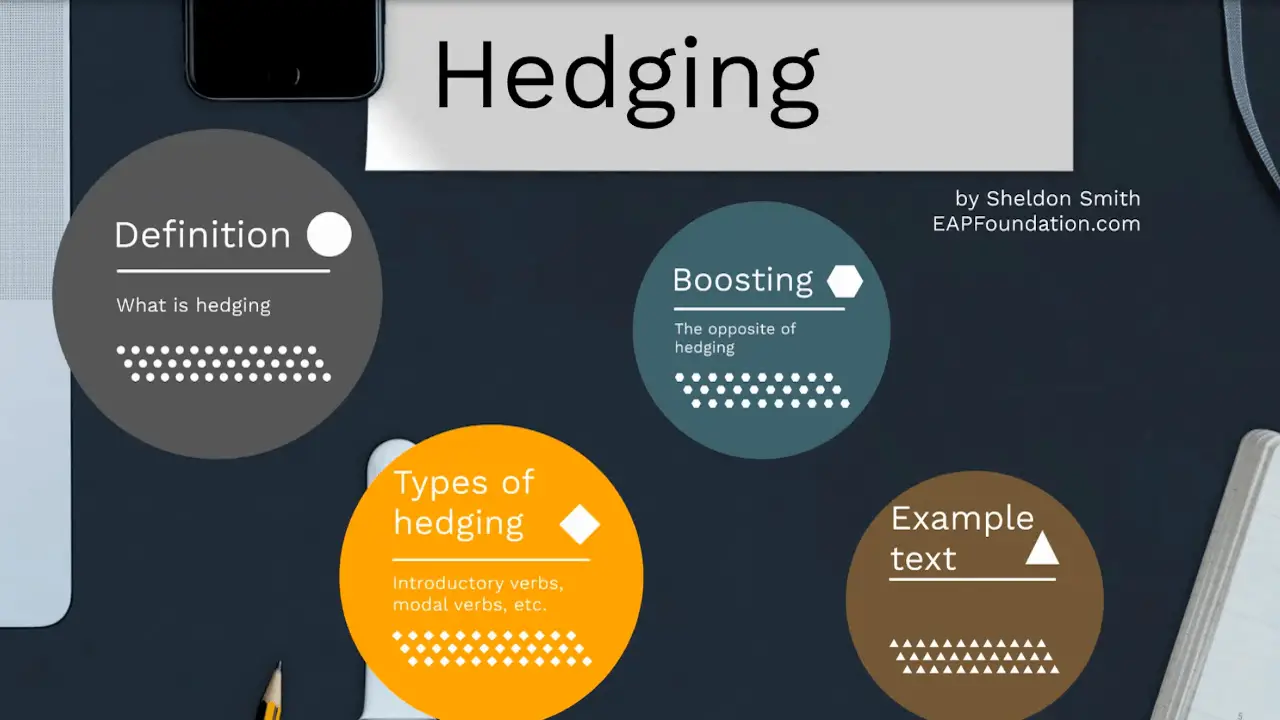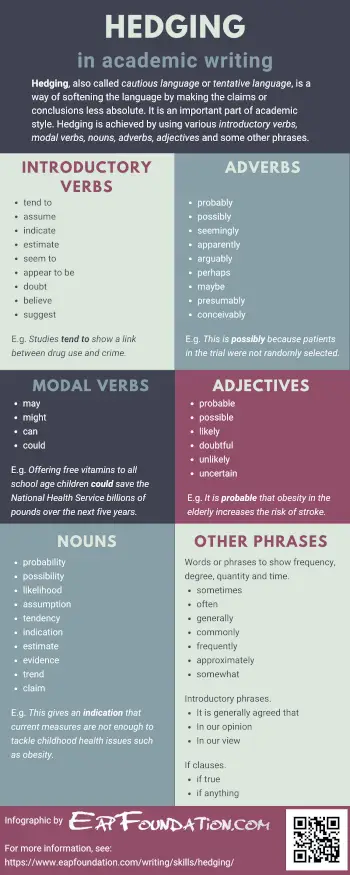Show AWL words on this page.
Show sorted lists of these words.


 







|
 Podcast is loading. Problems? Too slow? You can also access the Podcast by
clicking here.
Podcast is loading. Problems? Too slow? You can also access the Podcast by
clicking here.This message will disappear when then podcast has fully loaded.
Hedging, or 'being cautious', is an important component of academic style. This section explains what hedging is, then looks at different ways to hedge, namely using introductory verbs, modal verbs, adverbs, adjectives, nouns, and some other ways such as adverbs of frequency and introductory phrases. There is as an example passage so you can see each type of hedging in an authentic text, and, at the end, a checklist so you can check your understanding.
What is hedging?
Hedging, also called caution or cautious language or tentative language or vague language, is a way of softening the language by making the claims or conclusions less absolute. It is especially common in the sciences, for example when giving a hypothesis or presenting results, though it is also used in other disciplines to avoid presenting conclusions or ideas as facts, and to distance the writer from the claims being made.
The following is a short extract from an authentic academic text, with the hedging in blue (the full article is available here: https://doi.org/10.1136/bmj.j5855).
Although duration of smoking is also important when considering risk, it is highly correlated with age, which itself is a risk factor, so separating their effects can be difficult; however, large studies tend to show a relation between duration and risk. Because light smoking seems to have dramatic effects on cardiovascular disease, shorter duration might also be associated with a higher than expected risk.
Hedges can be contrasted with boosters (such as 'will' or 'definitely' or 'always'), which allow writers to express their certainty. These are less commonly used in academic writing, though tend to be overused by learners of academic English in place of more cautious language.
Introductory verbs
There are various introductory verbs which allow the writer to express caution rather than certainty in their writing. The following is a list of some of the most common ones. Some of these are linked to cautious nouns, adverbs or adjectives, in which case these are also given.
- tend to ➞ tendency (n)
- assume ➞ assumption (n)
- indicate ➞ indication (n)
- estimate ➞ estimate (n)
- seem to ➞ seemingly (adv)
- appear to be ➞ apparently (adv)
- doubt ➞ doubtful (adj)
- believe
- suggest
- think
Modal verbs
Another way of being cautious is to use the modal verbs expressing uncertainty, in place of stronger, more certain modals such as will or would. The following are modals which express uncertainty.
- may
- might
- can
- could
Adverbs
There are many adverbs which can be used to express caution. Some of these are associated with cautious adjectives or nouns, in which case these are also given. The adverbs can be divided into two types: modal adverbs, which are related to the possibility of something happening, and adverbs of frequency, which give information on how often something happens.
- probably ➞ probable (adj), probability (n)
- possibly ➞ possible (adj), possibility (n)
- seemingly ➞ seem to (v)
- apparently ➞ appear to be (v)
- arguably
- perhaps
- maybe
- presumably
- conceivably
Adjectives
The following adjectives can be used to express caution. Again, some of these are associated with other word forms, in which case these are also given.
- probable ➞ probably (adv), probability (n)
- possible ➞ possibly (adv), possibility (n)
- likely ➞ likelihood (n)
- doubtful ➞ doubt (v)
- unlikely
- uncertain
Nouns
The following nouns can be used to express caution. Some of these are associated with other word forms, in which case these are also given.
- probability ➞ probably (adv), probable (adj)
- possibility ➞ possibly (adv), possible (adj)
- likelihood ➞ likely (adj)
- assumption ➞ assume (v)
- tendency ➞ tend to (v)
- indication ➞ indicate (v)
- estimate ➞ estimate (v)
- evidence
- trend
- claim
Other phrases
There are three other ways to express caution. The first is to use words or phrases to show frequency, degree, quantity and time.
- sometimes
- often
- generally
- usually
- commonly
- frequently
- occasionally
- in general
- as a rule
- approximately
- roughly
- about
- reasonably
- somehow
- somewhat
The second way is to use introductory phrases, such as the following.
- It is generally agreed that
- In our opinion
- In our view
- It is our view that
- We feel that
- We believe that
- I believe that
- To our knowledge
- One would expect that
The final way is to use if clauses.
- if true
- if anything
Example passage
Below is an example passage. It is taken from the Limitations section of an article in the BMJ (formerly British Medical Journal). It is used to give examples of different types of hedging in an authentic academic text (use the buttons to highlight different types of hedging). The full article, published on 17 July 2019, is available here: https://www.bmj.com/content/366/bmj.l4786.
Introductory verbs |
Modal verbs | |
Adverbs |
Adjectives | |
Nouns |
Other | |
ALL |
This study has a few limitations. Firstly, we excluded 25% of the households from analysis because of missing
information on either income or BMI. It is
unlikely that such missing information is related to price elasticity
or purchase behaviour [...] however, it
may have resulted in some bias for the pooled values
across groups. [...]
Secondly, the baseline daily energy purchase estimates are sample average
estimates
that do not consider age or sex of the household members who could have different
energy requirements. [...] Thirdly, we used a static model for weight loss based on changes in energy consumption,
which might not fully reflect actual mechanisms of weight change.
[...] Fourthly, the study does not reflect on the substitution of
nutrients alongside changes in energy. For example, reduction in energy from high sugar snacks
could
lead to substitution of other foods that are lower in energy content but
perhaps higher in other
nutrients of concern, such as saturated fats or salt. The health impacts of such substitutes should
be further analysed and considered in the decision making process around food price policies.
Furthermore, the satiety index of sugary snacks
can vary greatly: some high sugar snacks
could
reduce overeating at meals, hence the overall impact of reduced consumption of high sugar snacks
would be partly cancelled out by consumption of larger portions during mealtimes. Studies of sugary
drinks only would be prone to this phenomenon, as the satiety effect of sugar sweetened beverages is
generally low.50 Fifthly, we
assumed that all food purchased was consumed, which is
unlikely, and
some food will inevitably be waste. However, although the link between purchasing and consumption
is far from perfect, it is strong (eg,51), and our
estimates on the effect of price rises on change in energy purchased is
likely to be similar to that on consumption even if absolute values differ.
Introductory verbs |
Modal verbs |
Adverbs |
Adjectives |
Nouns |
Other |
ALL |
References
Bailey, S. (2000). Academic Writing. Abingdon: RoutledgeFalmer
Hyland, K. (2006) English for Academic Purposes: An advanced resource book. Abingdon: Routledge.
Hyland, K. (2009) Academic Discourse: English in a Global Context. London: Continuum.
Jordan, R.R. (1997) English for Academic Purposes: A guide and resource book for teachers. Cambridge: Cambridge University Press.
Checklist
Below is a checklist. Use it to check your understanding.
| Item | OK? | Comment |
| I know what hedging is. | ||
| I know different introductory verbs which can be used for hedging (e.g. tend to, assume). | ||
| I know how modal verbs can be used for hedging. | ||
| I know some adverbs which can be used for hedging (e.g. possibly, probably). | ||
| I know some adjectives which can be used for hedging (e.g. likely, unlikely). | ||
| I know some nouns which can be used for hedging (e.g. estimate, trend). | ||
| I am aware of other types of language for hedging, i.e. phrases to show frequency, degree, quantity and time (e.g. sometimes, often, approximately, somewhat), introductory phrases (e.g. It is generally agreed that, In our opinion), and if clauses (if true, if anything). |
Next section
Read more about describing data in the next section.
Previous section
Go back to the previous section about transition signals.








